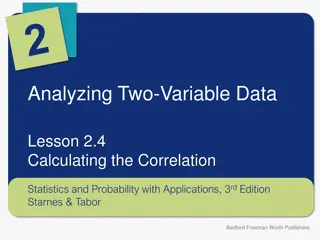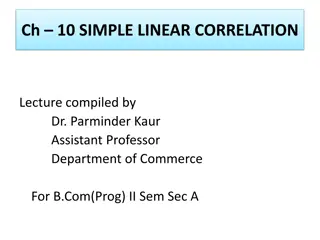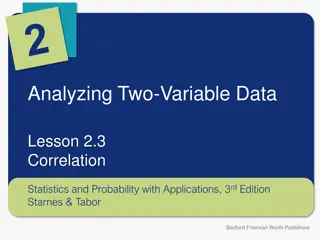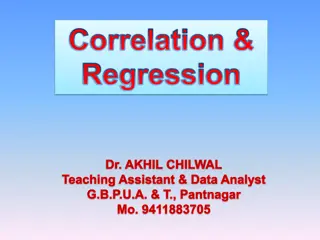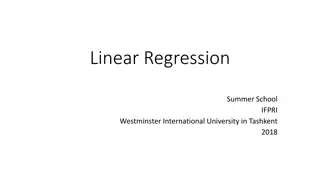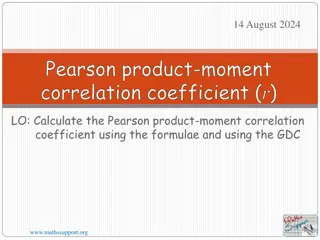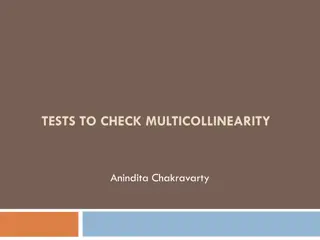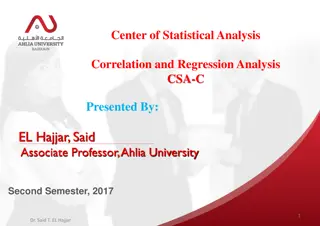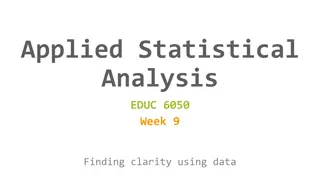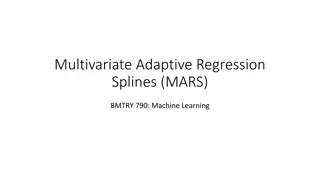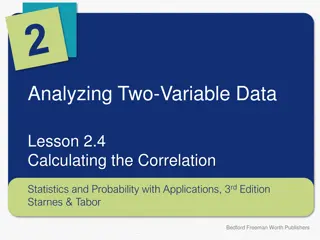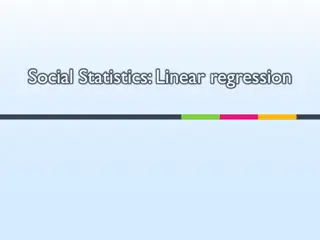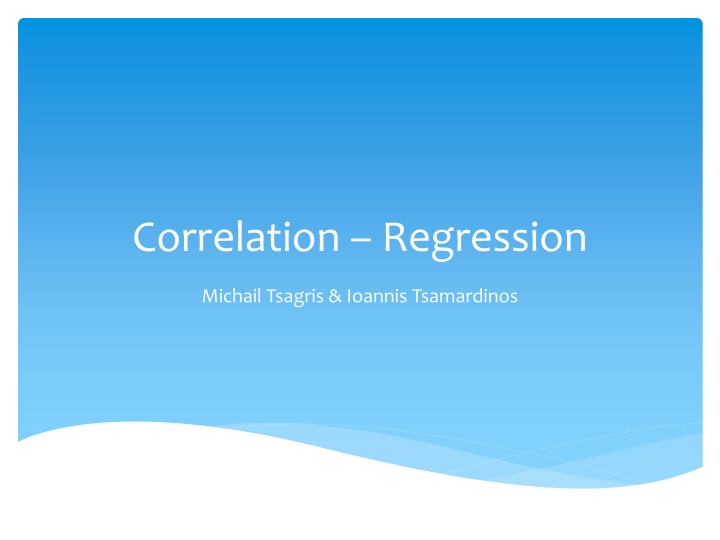
Understanding Correlation and Regression in Data Analysis
Learn about correlation and regression in data analysis, including continuous data, scatter plots, Pearson correlation coefficient, and quantifying relationships between variables. Explore the concept of linear relationships and how to interpret correlation coefficients.
Download Presentation

Please find below an Image/Link to download the presentation.
The content on the website is provided AS IS for your information and personal use only. It may not be sold, licensed, or shared on other websites without obtaining consent from the author. If you encounter any issues during the download, it is possible that the publisher has removed the file from their server.
You are allowed to download the files provided on this website for personal or commercial use, subject to the condition that they are used lawfully. All files are the property of their respective owners.
The content on the website is provided AS IS for your information and personal use only. It may not be sold, licensed, or shared on other websites without obtaining consent from the author.
E N D
Presentation Transcript
Correlation Regression Michail Tsagris & Ioannis Tsamardinos
Continuous data Continuous data are data that can take any value, either within a specific range or anywhere on the real line. E.g. weight, height, time, glucose level, etc.
Continuous data Continuous data are data that can take any value, either within a specific range or anywhere on the real line. E.g. weight, height, time, glucose level, etc. Suppose now that we have measurements from two or more quantities and want to see whether there is a (linear) relationship between them or not.
Correlation Continuous data are data that can take any value, either within a specific range or anywhere on the real line. E.g. weight, height, time, glucose level, etc. Suppose now that we have measurements from two or more quantities and want to see whether there is a (linear) relationship between them or not. The answer is either Pearson s (most popular) or Spearman s correlation coefficient.
Scatter plot Observe the positive trend. Body weight increases, so does the brain weight.
Can we quantify this relationship? We want a number to describe this relationship, something to concentrate as much information we get from this graph as possible. The answer is the Pearson s correlation coefficient. For this dataset its value is 0.78 (!! what does it mean?)
Pearson correlation coefficient The coefficient usually denoted as r ( for the population) between two variables X and Y is defined as ? ? ? ? ?=1 ???? ?=1 ?? ?=1 ?? ? = 2, 2 ? ? ? ? 2 ?=1 2 ?=1 ? ?=1 ? ?=1 ?? ?? ?? ?? where n is the number of measurements. The coefficient takes values between -1 (perfect negative correlation) and 1 (perfect positive correlation).
Pearson correlation coefficient Zero values indicate lack of linear relationship.
Example Gene X Gene Y 6 5 5 4 7 6 4 7 7 6
Example Gene X Gene Y 6 5 5 4 7 6 4 7 7 6 Sum 29 28
Example X2 Y2 Gene X Gene Y X*Y 6 5 30 36 25 5 4 20 25 16 7 6 42 49 36 4 7 28 16 49 7 6 42 49 36 Sum 29 28 162 175 162
Example ? ?? ? ? ? ?2 ?2? ?2 ?2 ? = 5 162 29 28 5 175 2925 162 282= 0.067 ? = Close to 0, not so strong linear relationship.
Spearmans correlation coefficient What about Spearman s correlation coefficient? Spearman s correlation is basically the Pearson s correlation applied to the ranks(?) of the data. We rank each variable separately and use the ranks to calculate the Pearson s correlation coefficient.
Example: ranks Gene X Gene Y Rx Ry 6 5 3 2 5 4 2 1 7 6 4.5 3.5 4 7 1 5 7 6 4.5 3.5
Pearson or Spearman? Pearson implies that the data are normally distributed, each variable follows a normal distribution. Spearman assumes that the ranks follow a normal distribution. Thus, more robust to deviations from normality. Pearson is sensitive to oultiers (data far from the rest). Spearman is very robust to outliers. Pearson has better theoretical properties.
Hypothesis test for the correlation coefficient How can we test the null hypothesis that the true correlation is equal to some specified value? ??: ? = ?0 ?1: ? ?0
Hypothesis test for the correlation coefficient We will use Fisher s transformation ? = ?.? ???(?+? ? ?) 0= 0.5 log(1+?0 1 ?0) (under ?0) 1= 0.5 log(1+?1 1 ?1) (under ?1) 1 0 1/ ? 3Pearson correlation Pearson correlation ??= 1 0 ??= ?.??????/ ? 3Spearman correlation Spearman correlation
Hypothesis test for the correlation coefficient If ???? ?? ?1 ? 2,? 3reject the H0. If n > 30 you can also use the next decision rule If ???? ?? ?1 ? 2reject the H0. For the case of ? = 0, the two Ts become 1 ??= 1/ ? 3Pearson correlation Pearson correlation 1 ?.??????/ ? 3Spearman correlation Spearman correlation ??=
Simple linear regression What is the formula of the line segment?
Simple linear regression The formula is ??= ? + ???+ ??. In order to estimate the ? and ? we must minimise the sum of the squared residuals ??: Minimise ?=1 ?? with respect to ? and ?. 2= ?=1 ? ? 2 ?? ? ???
Estimates of a and b ? ?? ? ? ? ?2 ?2(r = ? ?? ? ? ? ?2 ?2? ?2 ?2) ? = ? = ? ? ? ?: if x is zero, the estimated value of y. ?: the expected change in y if x is increased ( decreased) by a unit (in x values).
Multiple regression ? ??= ? + ?=1 The estimation of betas uses matrix algebra. ????+ ??.
Dummy variables Sex = Male or Female. S = {0, 1}, Where 0 stands for M (or F) and 1 stands for F (or M). Race = White, Black, Yellow, Red. R1 = 1 if White and 0 else R2 = 1 if Black and 0 else R3 = 1 if Yellow or else. Red is the reference value in this case.
Coefficient of determination ?2:The percentage of variance of y explained by the model (or the variable(s)). ? 2 ?=1 ?? ? ??? ?=1 ?? ?2 ??? ??? ?2= 1 = 1 ? ?2= cor(y, ?).
Categorical data What if we have categorical data? How can we quantify the relationship between gender and smoking in young ages, gender and lung cancer, smoking and lung cancer for example? How can we decide whether these pairs are statistically dependent or not? The answer is G2test of independence. Ho : The two variables are independent H1: The two variables are NOT independent
G2test of independence ??? ???, ?2= 2 ?,????log where e and n denote the expected and the observed frequencies respectively. The 2 variables have I and J distinct values and i = 1, 2, , I and j = 1, 2, , J. But how do we calculate the e terms? ???= ? , where ??.is the total of the i-th row, ?.?is the total of the j-th column and n is the sample size. ??.?.?
Gender Totals Male Female ?11= 50 ?12= 10 ??.= ?? Cancer Yes ?21= 3 ?22= 5 ??.= 8 No ?.1= 53 ?.?= ?? ? = ?? Totals ?11=??. ?.? 60 53 68 = = 46.76 ? ?12=??. ?.? =?? ?? = 13.24 ? 68 G2test of independence ?21=??. ?.? ? ?22=??. ?.? ? =8 53 = 6.24 68 =8 15 = 1.76 68
G2 test of independence 50 10 ?2= 2 ( 50 log 46.76+ 10 log 5 1.76 ) = 2 * 3.57 = 7.14 13.24+ 3 3 log 6.24+5 log What is next?
G2 test of independence We need to see whether G2 =7.14 is large enough to reject the null hypothesis of independence between the two variables. We need a distribution to compare against. The answer is X2 at some degrees of freedom. DF = (#rows - 1) * (# columns - 1) In our example (2 - 1) * (2 - 1) = 1 Since G2 =7.14 < ?1,0.95 = 3.84 we reject the null hypothesis. Hence the two variables can be considered dependent (statistically speaking) or non independent. 2


